
Frederik Christian Willerup (5 February 1742 - 7 May 1819) was a Danish sculptor who worked at the Royal Danish Dockyard on Holmen in Copenhagen. He lived most of his life in Denmark-Norway.

Frederik Christian Willerup (5 February 1742 - 7 May 1819) was a Danish sculptor who worked at the Royal Danish Dockyard on Holmen in Copenhagen. He lived most of his life in Denmark-Norway.
Willerup was born on 5 February 1742 in Copenhagen, the son of Andreas Willerup and Anna Cathrine Holm, He was married to Anne Dorthea Kisbye )1759-1836).
Willerup worked as the navy's sculptor at the Royal Danish Shipyard from 1776. He was responsible for creating figureheads, gallery ornamentation and other ornamental features for the ships constructed at the shipyard. [1]
He also made figureheads and ornaments for private shipowners, for instance at Larsens Plads, where a young Bertel Thorvaldsen and his father Gotskalk Thorvaldsen also worked. Thorvaldsen carved a wooden relief for a gate of a rider on horseback (now in Thorvaldsens Museum), after Willerup's drawing. Without the model's knowledge, Thorvaldsen also executed a portrait of Willerup in 1796. According to Just Matthias Thiele's Thorvaldsen biography (Vol. III, p. 50), Willerup had requested "a small work in remembrance" from his young colleague, before Thorvaldsen's departure for Rome. Thorvaldsen did not immediately seem to have complied with the request, but after his departure the bust was found in a box with the inscription: "for Willerup". [1] The portrait is not known today. [1]
Other works by Willerup include four allegorical sculptures of "The Four Winds" for the new Knippel Bridge in Copenhagen. They are now in the collection of the Museum of Copenhagen. [2]

Albert Bertel Thorvaldsen was a Danish-Icelandic sculptor and medalist of international fame, who spent most of his life (1797–1838) in Italy. Thorvaldsen was born in Copenhagen into a working-class Danish/Icelandic family, and was accepted to the Royal Danish Academy of Art at the age of eleven. Working part-time with his father, who was a wood carver, Thorvaldsen won many honors and medals at the academy. He was awarded a stipend to travel to Rome and continue his education.

Christen Schiellerup Købke was a Danish painter, and one of the best-known artists from the Golden Age of Danish Painting.

Christoffer Wilhelm Eckersberg was a Danish painter. He was born in Blåkrog in the Duchy of Schleswig. He went on to lay the foundation for the period of art known as the Golden Age of Danish Painting, and is referred to as the "Father of Danish painting".

Johannes Wiedewelt, Danish neoclassical sculptor. He became a court sculptor, introducing neoclassical ideals to Denmark in the form of palace decorations, garden sculptures and artifacts and, especially, memorial monuments. He was undoubtedly the best known Danish sculptor before Bertel Thorvaldsen.
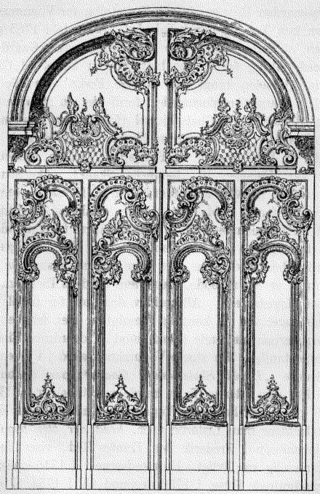
Louis August le Clerc, also known as Louis-Augustin le Clerc, was a French-born sculptor working in Denmark. He was born in Metz, France to copperplate engraver Sebastian le Clerc and his wife Charlotte van den Kerckhove. He was summoned to Denmark at the age of 47, and lived out the rest of his life there as a royal sculptor to the Danish Court and as professor at the Royal Danish Academy of Art. He helped introduce French Rococo artistic ideals to Denmark.
The Danish Golden Age covers a period of exceptional creative production in Denmark, especially during the first half of the 19th century. Although Copenhagen had suffered from fires, bombardment and national bankruptcy, the arts took on a new period of creativity catalysed by Romanticism from Germany. The period is probably most commonly associated with the Golden Age of Danish Painting from 1800 to around 1850 which encompasses the work of Christoffer Wilhelm Eckersberg and his students, including Wilhelm Bendz, Christen Købke, Martinus Rørbye, Constantin Hansen and Wilhelm Marstrand, as well as the sculpture of Bertel Thorvaldsen.

Joakim Frederik Schouw was a Danish lawyer, botanist and politician. From 1821, professor in botany at the University of Copenhagen — first extraordinary professor, but after the death of J.W. Hornemann in 1841 ordinary. His main scientific field was the new discipline of phytogeography. He also served as director of Copenhagen Botanical Garden in 1841-1852. He was a leading figure in the National Liberal movement and president of the Danish Constituent Assembly in 1848.

Michael Gottlieb Birckner Bindesbøll was a Danish architect active during the Danish Golden Age in the first half of the 19th century. Most known for his design of Thorvaldsens Museum in Copenhagen, he was a key figure in the stylistic shift in Danish architecture from late classicism to Historicism. He was the father of the designer Thorvald Bindesbøll and the textile artist Johanne Bindesbøll.

The Thorvaldsen Museum is a single-artist museum in Copenhagen, Denmark, dedicated to the art of Danish and Icelandic Neoclassical sculptor Bertel Thorvaldsen (1770–1844), who lived and worked in Rome for most of his life (1796–1838). The museum is located on the small island of Slotsholmen in central Copenhagen next to Christiansborg Palace. Designed by Michael Gottlieb Bindesbøll, the building was constructed from 1838 to 1848 following a public collection of funds in 1837.
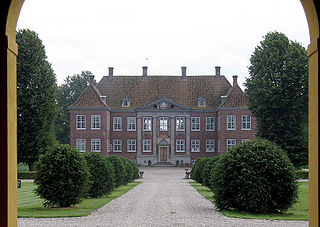
Nysø Manor, located near Præstø in the southeast of the Danish island of Sealand, was built in 1673 for Jens Lauridsen, a local functionary. It now houses the Thorvaldsen Collection, a group of works by the Danish sculptor Bertel Thorvaldsen, who lived and worked there in his later years.
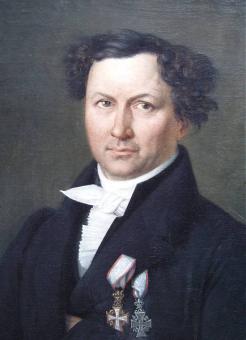
Jørgen Hansen Koch was a Neoclassical Danish architect. He was chief of the national Danish building administration from 1835 and director of the Royal Danish Academy of Fine Arts from 1844 to 1849.
Events from the year 1819 in Denmark.
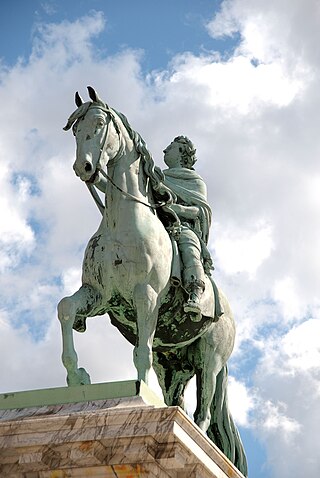
Danish sculpture as a nationally recognized art form can be traced back to 1752 when Jacques Saly was commissioned to execute a statue of King Frederick V of Denmark on horseback. While Bertel Thorvaldsen was undoubtedly the country's most prominent contributor, many other players have produced fine work, especially in the areas of Neoclassicism, Realism, and in Historicism, the latter resulting from growing consciousness of a national identity. More recently, Danish sculpture has been inspired by European trends, especially those from Paris, including Surrealism and Modernism.

Rasmus Morten Andersen was a Danish sculptor. He is mainly known for his naturalistic portraits.

Ludvig Brandstrup was a Danish sculptor. He is remembered above all for his equestrian statue of Christian IX in Esbjerg but was also one of the most competent portraitists of his day.
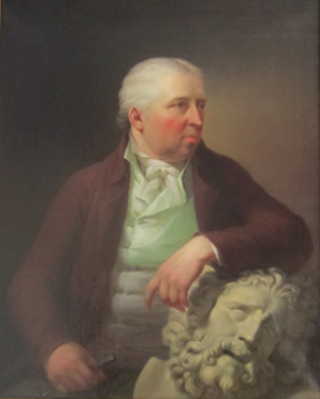
Nicolai Dajon was a Danish sculptor. He served as director of the Royal Danish Academy of Fine Arts from 1818 to 1821.

Christen Christensen was a Danish sculptor and medallist. His works as a medallist include the Royal Danish Academy of Fine Arts' C. F. Hansen Medal and Thorvaldsen Medal.

HDMS Rota was a frigate of the Royal Danish Navy. She is above all remembered for being the ship that, in 1838, picked up the sculptor Bertel Thorvaldsen and many of his artworks in Livorno and brought them back to Denmark. Hans Dahlerup, her captain, and Alexander Wilde, then a junior lieutenant, have both described the voyage in their memoirs. In 1863, Rota was sold to H. Puggaard & Co. and converted into a civilian merchant ship. She wrecked off the coast of southern Norway in 1892, some ten years after being sold to Paul Larsen, Arendal.

HDMS Thetis was a frigate of the Royal Danish Navy, which she served from 1842 to 1864. She is best known for being one of the ships that picked up some of the sculptor Bertel Thorvaldsen's artworks and other belongings in Rome, some forty years after another Danish naval vessel by the same name had transported him the other way. In the meantime he had achieved international fame for his Neoclassical sculptures. Thorvaldsen, who had been back in Rome since September 1841, after moving back to Copenhagen in 1838, was also supposed to return with the ship. He did however, miss its departure by one day. The Royal Danish Navy's first music corps played its first performance on board the Thetis in 1857.

HDMS Thetis was a frigate of the Royal Dano-Norwegian Navy, which she served from 1790 to 1850. She is remembered as the ship that carried a young Bertel Thorvaldsen to Malta in 1796. The sculptor ended up living and working in Rome the next more than forty years. He created a large number of small portrait drawings of the officers on board the ship.